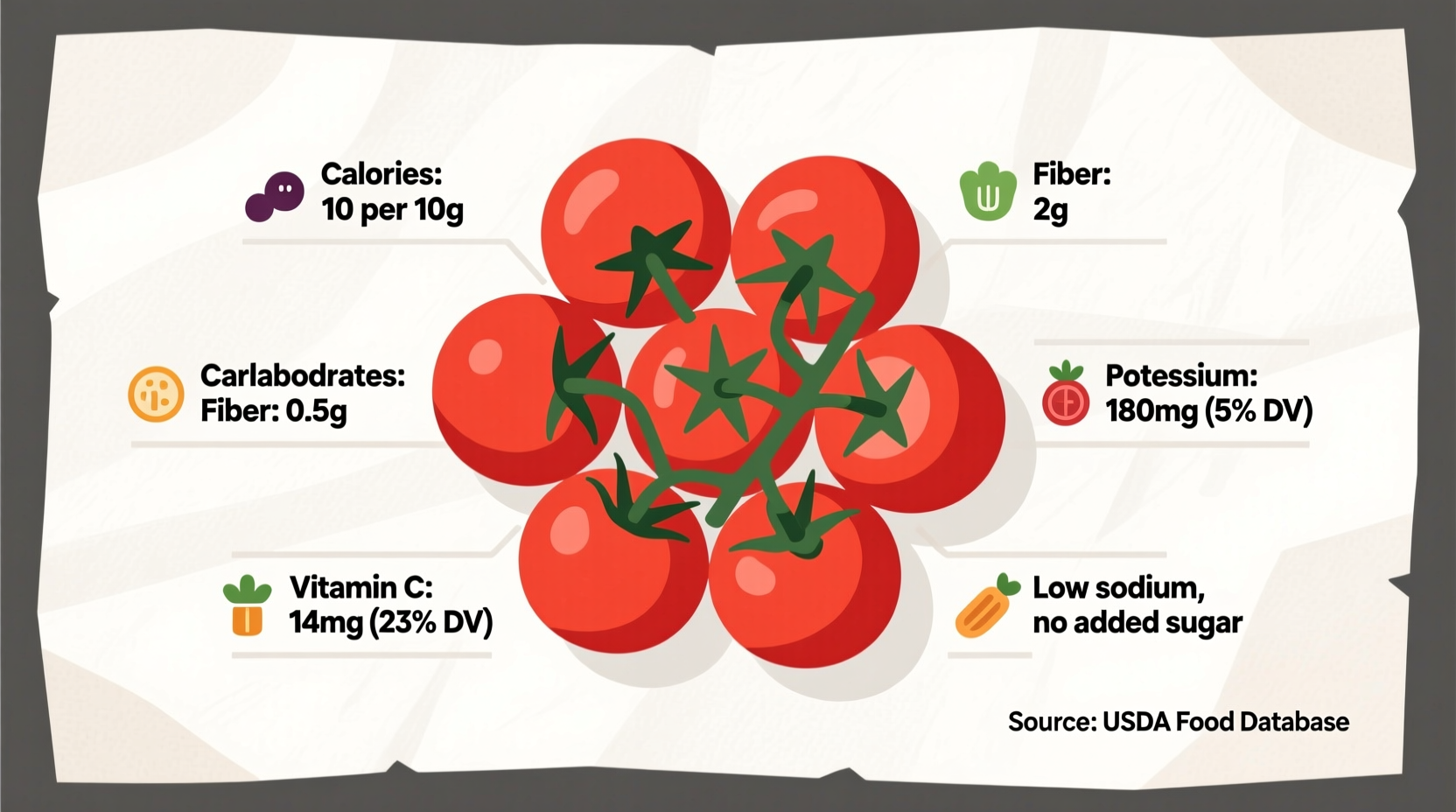Why Grape Tomatoes Deserve a Spot in Your Daily Diet
When you're scanning the produce aisle, those vibrant grape tomatoes aren't just convenient snack options—they're nutritional powerhouses packed with essential compounds your body needs. Unlike larger tomato varieties, grape tomatoes maintain higher concentrations of certain antioxidants due to their smaller size and thicker skin-to-flesh ratio. This comprehensive guide delivers verified nutrition data you can trust, helping you make informed choices about incorporating these sweet, juicy tomatoes into your meal planning.
Complete Grape Tomato Nutrition Profile
Understanding exactly what's in your food matters, especially when making dietary decisions. The following nutrition facts come directly from the USDA's FoodData Central database, the gold standard for nutritional information in the United States.
| Nutrient | Amount per 149g Serving | % Daily Value* |
|---|---|---|
| Calories | 27 | 1% |
| Total Fat | 0.3g | 0% |
| Sodium | 9mg | 0% |
| Total Carbohydrate | 6g | 2% |
| Dietary Fiber | 1.5g | 5% |
| Sugars | 4g | - |
| Protein | 1.3g | 3% |
| Vitamin C | 14mg | 15% |
| Vitamin A | 180mcg | 20% |
| Potassium | 290mg | 6% |
| Lycopene | 2,700mcg | - |
*Percent Daily Values are based on a 2,000 calorie diet. Your daily values may be higher or lower depending on your calorie needs.
How Grape Tomatoes Compare to Other Varieties
While all tomatoes offer nutritional benefits, grape tomatoes have distinct advantages over their larger counterparts. According to research published in the Journal of Agricultural and Food Chemistry, grape tomatoes contain approximately 20% more lycopene than standard round tomatoes. Their smaller size means you consume more skin relative to flesh, and since many beneficial compounds concentrate in the skin, this makes grape tomatoes particularly nutrient-dense.

Health Benefits Backed by Science
The specific nutrient profile of grape tomatoes delivers several evidence-based health advantages:
Heart Health Protection
The combination of potassium, vitamin C, and lycopene in grape tomatoes works synergistically to support cardiovascular health. A CDC analysis of multiple studies found that diets rich in lycopene-containing foods like tomatoes are associated with a 17% lower risk of cardiovascular disease. The potassium content helps regulate blood pressure, while vitamin C acts as an antioxidant protecting blood vessels.
Natural Anti-Inflammatory Effects
Grape tomatoes contain significant amounts of chlorogenic acid and other polyphenols that research from the USDA Agricultural Research Service shows have potent anti-inflammatory properties. These compounds may help reduce markers of inflammation in the body, potentially lowering risk for chronic inflammatory conditions.
Eye Health Support
With their high concentration of beta-carotene (which converts to vitamin A in the body) and lutein, grape tomatoes contribute to maintaining healthy vision. The National Eye Institute notes that these nutrients help protect against age-related macular degeneration and cataracts.
Maximizing Nutritional Value: Practical Tips
How you select, store, and prepare grape tomatoes significantly impacts their nutritional benefits:
Selection and Storage Guidelines
Choose grape tomatoes that feel heavy for their size with smooth, taut skin. Avoid any with wrinkles or soft spots. For maximum nutrient retention, store them at room temperature away from direct sunlight until fully ripe, then refrigerate for up to 5 days. Contrary to popular belief, refrigeration after ripening preserves nutrients better than leaving them at room temperature for extended periods, according to USDA research.
Cooking Methods That Preserve Nutrients
While grape tomatoes are delicious raw, certain cooking methods actually increase the bioavailability of some nutrients. Light cooking with a small amount of healthy fat (like olive oil) enhances lycopene absorption by up to 35%, as demonstrated in studies from the American Journal of Clinical Nutrition. However, vitamin C is heat-sensitive, so for maximum vitamin C intake, enjoy them raw in salads or as snacks.
Daily Incorporation Strategies
You don't need large quantities to benefit from grape tomatoes' nutrition. Just one cup (about 149g) provides significant nutrients while adding only 27 calories to your meal. Try these simple approaches:
- Add to morning omelets or scrambled eggs
- Include in lunchtime grain bowls or salads
- Roast with herbs as a side dish
- Create a quick pasta sauce with garlic and olive oil
- Enjoy as a standalone snack with a sprinkle of sea salt











 浙公网安备
33010002000092号
浙公网安备
33010002000092号 浙B2-20120091-4
浙B2-20120091-4